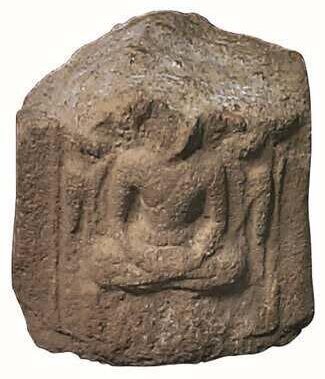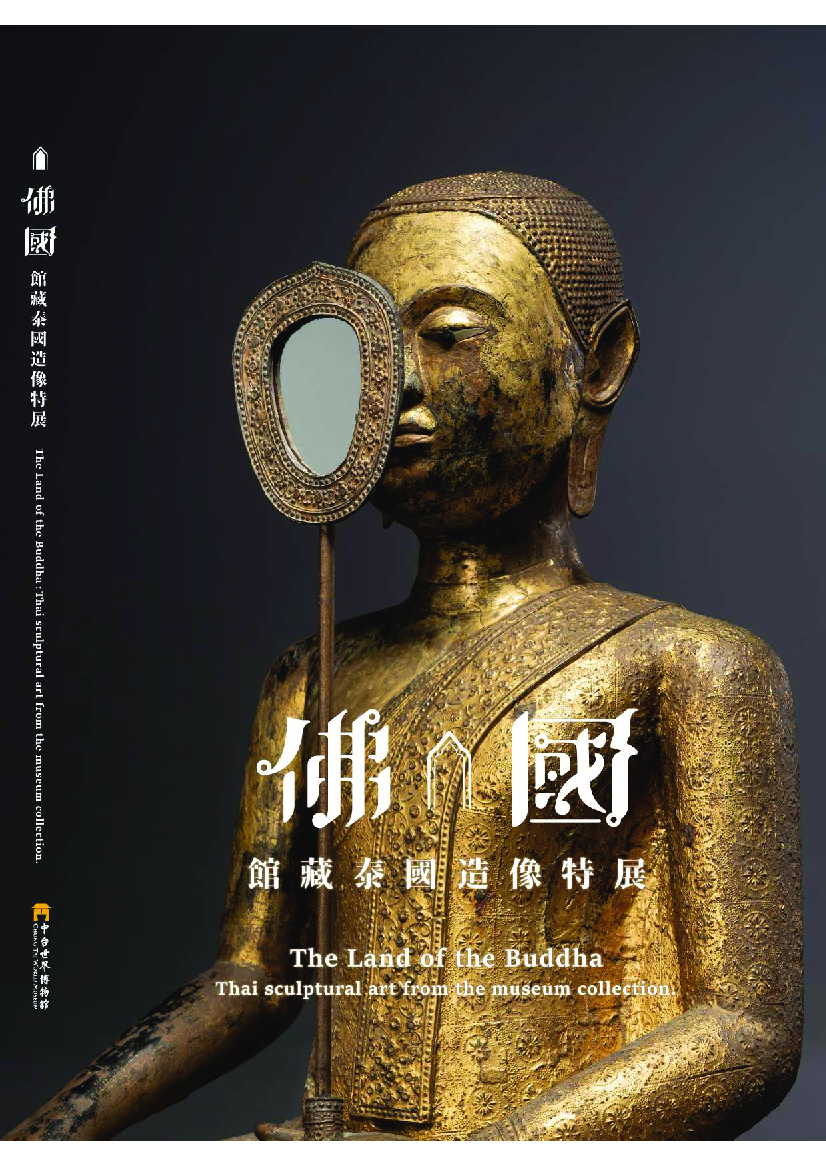From devotional objects and sculptures found in the area now known as central Thailand, the author offers several perspectives on beliefs and rituals in the Mon-Khmer cultural sphere, including:
- “The ideology of merit is an intrinsic concept in Buddhism and has been a major motivation for the production of art since its inception in India and Southeast Asia. Merit can, of course, be gained in a number of ways and the Pāli Canon identifies several bases of merit, the most basic of which is showing humility and paying respect ( apacayana ) to the three gems or triratana (i.e., the Buddha, the Dhamma , and the Saṅgha). Probably echoing this belief, the 7th century Chinese travelling monk Yijing (635−713) reported for mainland Southeast Asia that “the inhabitants of all these countries greatly [pay] reverence [to] the Three Jewels (Ratnatraya) [sic]” (Takakusu 1998: 10). Archaeological evidence supports this statement. A clay Buddhist tablet found in Khok Mai Den, Nakhon Sawan province is engraved in Pāli with the following homage: buddhassa namo dhammassa namo saṅghas(sa), i.e., “Homage to the Buddha, Homage to the Dhamma , Homage to the Saṅgha” (FAD 2529: I, 287 – 291; Fig. 2b). Another “eulogy inscription” of uncertain date, found at Noen Sa Bua, Prachin Buri province, gives a similar salutation to the three gems in ornate Pāli verses (PCh 14/K. 997). These verses come from the opening homage of the Sinhalese Telakaṭāhagāthā and, because of this correspondence, various attempts have been made to demonstrate the early “establishment of Sri Lankan Buddhism” in Thailand during the so-called Dvāravatī period. This effort, however, has not been devoid of important biases and methodological problems and the above assertion has ultimately been refuted.”
- As an investment in ritual actions “may eventually yield great results, an additional important function of these sacred verses concerns the religious merit generated by copying and reciting them. The merit accrues for both the scribe who engraves them and the person who recites the gāthās . We do not know when and where exactly this practice was first employed in India, but Yijing, in the 7th century, has described this tradition as concomitant with the making of Buddha images: The priests and the laymen in India make caityas or images with earth, or impress the Buddha’s images on silk or paper, and worship it with offerings wherever they go. […] Any one may thus employ himself in making the objects of worship. Again, when the people make images and caityas which consist of gold, silver, copper, iron, earth, lacquer, bricks, and stone, or when they heap up the snowy sand (lit. sand-snow), they put in the images or caityas two kinds of sarīras [i.e., relics]. 1. The relics of the Great Teacher. 2. The gāthā of the Chain of Causation [i.e., ye dhammā or paṭiccasamuppāda gāthās ]. […] If we put these two in the images or caityas , the blessings derived from them are abundant. This is the reason why the sūtras praise in parables the merit of making images or caityas as unspeakable. (Takakusu 1998: 150 – 151; with minor stylistic changes). By this time, copying a verse (gāthā ), just as copying an image ( pratimā ), was cle arly perceived as a beneficial act of merit in itself, not only for the scribe or the image-maker but also for the donor who sponsored the act of copying. This is also to say that this practice of duplicating a religious object was no longer motivated by the intention of preserving the “exact word” or “likeness” of the Buddha but rather was primarily aimed at merit-making. Hence, producing and copying a large number of Buddha images, for example miniature clay tablets or earthenwares (Guy 2002; Skilling 2009: 108 – 109), and engraving them with such Pāli verses would necessarily result in great benefits.
- In closing, the author notes that “the analysis of these Buddhist practices and rituals, as gleaned from the archaeological and epigraphic records of Dvāravatī and to a lesser extent its neighbouring cultures, has now come full circle. In the spirit of reassessing past scholarship, I have attempted to re-examine the corpus of ancient material and inscriptions from both a historical and doctrinal angle. The study has clearly demonstrated the essential Buddhist ideologies of gift-giving and dedicating that are conducive to meritmaking, often directed toward a good “rebirth” in a future existence. The purpose of accumulating merit has become the most important goal of the modern follower of Buddhism in Thailand. We have also seen how crucial ritual elements include the act of producing, and at times inscribing the objects with certain sacred verses that are deemed most effective. This also adds to our understanding of essential Buddhist approaches to meritmaking. Particularly instructive are the regional distribution of such artefacts and the language of the epigraphs (Map 1). Among the Buddhist artefacts found in profusion are the objects inscribed in Pāli, from present-day central Thailand, or in Old Mon, mainly from the contemporary northeast. Sanskrit and Old Khmer are also attested in a few donation inscriptions found in the outskirts of the Dvāravatī cultural sphere where cases of regional bilingualism (e.g., Mon-Pāli, Mon-Sanskrit, Mon-Khmer) are indicated. These linguistic trends may be an indication of the two major ethnic groups living in the region (i.e. Mon and Khmer) and of the sacred languages used (Pāli and Sanskrit). Although it cannot be concretely established that the Dvāravatī rulers of central Thailand were Buddhists, several inscriptions show that a significant portion of the population at least supported Buddhist temples and monasteries by the 7th and 8th centuries CE. This is a clear indication that Buddhism firmly took root in Thailand only from this period onwards and not as far back as the time of King Asoka, circa 250 BCE, as is often accounted in local traditions and school textbooks (Revire 2018).”
ADB input: The author warns that “in this essay, “Dvāravatī” refers to both an archaeological typology and a cultural entity vaguely located in west-central Thailand circa the 7th and 8th centuries CE.” In general, scholars reckon that Dvaravati (Thai: ทวารวดี, probably from Sanskrit śrī dvāravatī, dvāravatī meaning “the one with gates”) was an ancient Mon kingdom from the 7th century to the 11th century, located in the region now known as central Thailand. It was described by the Chinese pilgrim in the middle of the 7th century as a Buddhist kingdom named To-lo-po-ti situated to the west of Isanapura (Cambodia) and to the east of Sri Ksetra (Burma). The culture of Dvaravati was based around moated cities, the earliest of which appears to be U Thong in what is now Suphan Buri Province, Nakhon Pathom, Phong Tuk, Si Thep, Khu Bua and Si Mahosot… A Khmer inscription dated 937 documents a line of princes of Chanasapura started by a Bhagadatta and ended by a Sundaravarman and his sons Narapatisimhavarman and Mangalavarman. Dvaravati began to come under the influence of the Khmer Empire and central Southeast Asia was ultimately invaded by King Suryavarman II in the first half of the 12th century. Hariphunchai survived its southern progenitors until the late 13th century, when it melted into Lan Na.]
Kessara Srinaka, while studying the contribution of Leading Thai art historian Piriya Krairiksh in the book Decoding Southeast Asian Art, noted that “Achan Piriya holds that many art styles or schools, as
well as many styles, have existed in combination during the same historical period. In some cases, though the political power of a kingdom has waned, certain art styles might yet persist. The rise and fall of kingdoms and states do not necessarily entail changes in art styles. Secondly, political terms of reference can lead to conflating historical periods and art styles, since the use of terms such as Dvāravatī era, Śrīvijaya and Chiang Saen implies that we are talking mainly about historical periods, without any relation to the real art style. Achan Piriya therefore has refrained from using such
labels as Dvāravatī art, Śrīvijayan art and Lopburi art in all of his writings since 1977. He also holds that if the center of a kingdom cannot be clearly identified, it should not be used as a framework for dividing the stylistic periods as such. Conversely, mainstream art historians have generally used the term “Dvāravatī art” in the past to describe the expansion of political influence of the state and kingdom, because of the discovery of artworks with related characteristics in different areas. Thus, they have traditionally surmised that the so-called Dvāravatī kingdom constituted the territory which covered all of these areas where the artworks were discovered. Subsequently, all of such works were categorized as belonging to the art of Dvāravatī even though it was believed in the past that Dvāravatī had no clear center. Achan Piriya also argues that Dvāravatī was only “one among several Mon cities which had prospered during that period. Thus, the label ‘Dvāravatī’ was only suitable for use in history and politics, whereas ‘Dvāravatī’ as an art style should be replaced with ‘Mon’, since this word is generally used for cultural purposes” (2523: 13). More precisely, Dvāravatī was probably a Mon state which prospered during that time.”
Photo: Obverse of a clay Buddhist tablet found in Khok Mai Den, Nakhon Sawan province, 7th – 8th c. Currently located in the Bangkok National Museum, inv. no. 923⁄2508 [Photograph courtesy of Disapong Netlomwong].



